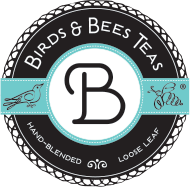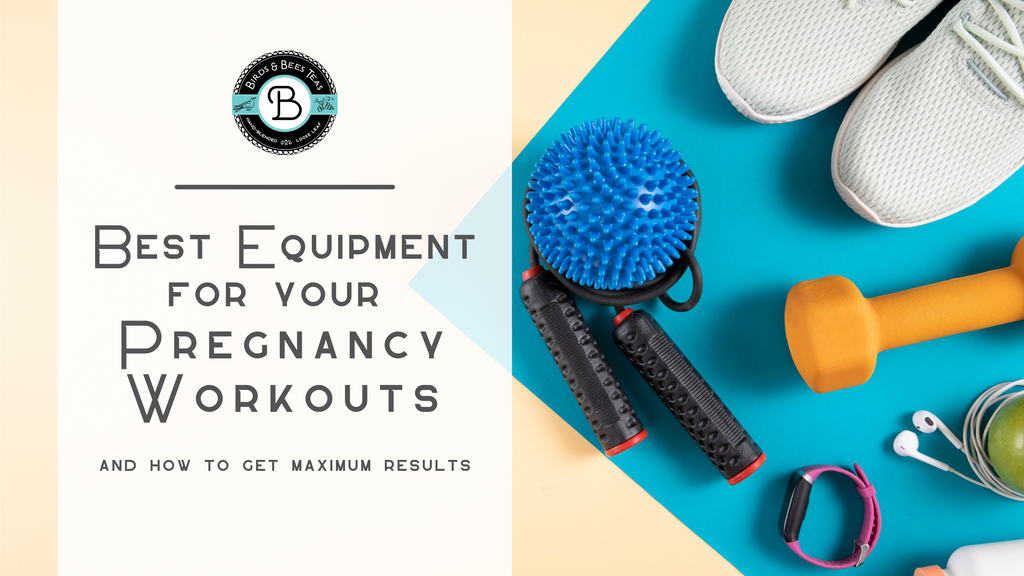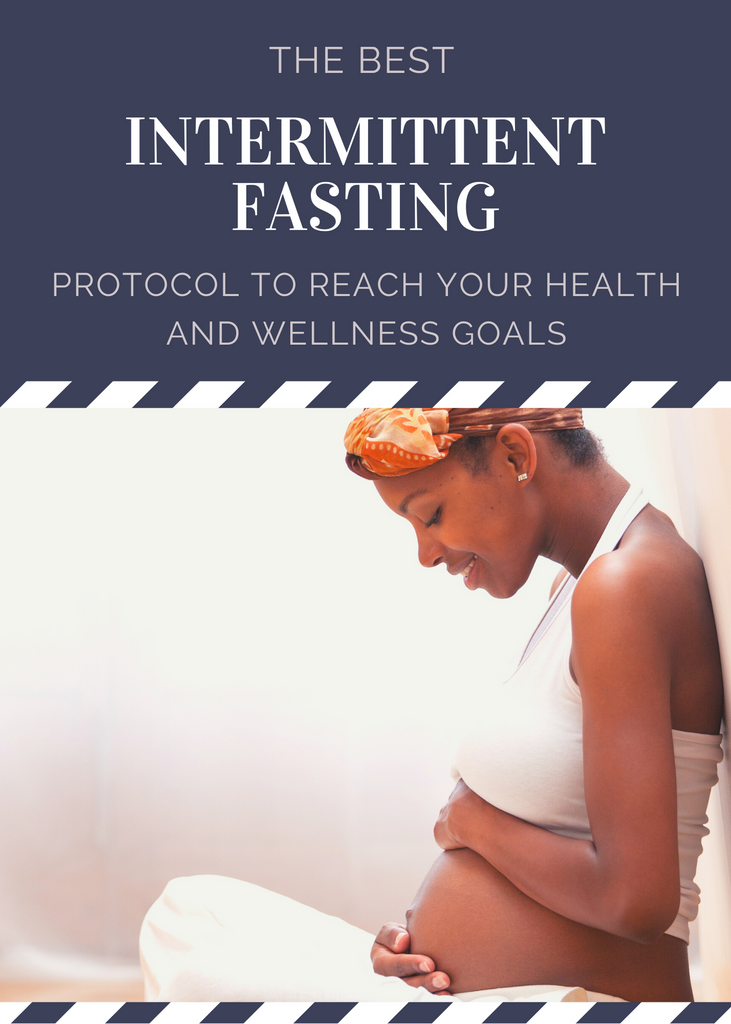Best Equipment for your Pregnancy Workouts Best Equipment for your Pregnancy Workouts
All the best things to have on hand for pregnancy workouts AND what they’re good for!
Since our last article went over squats and kegels, we decided to continue with the theme of prenatal fitness, and give you a list of equipment that will help you be more active during pregnancy! So, when you put down the snacks (because trust us, you’ll be snacking), have these things close by!
1. An Exercise Ball
Getting comfortable when you’re pregnant can be the actual worst. So, an exercise ball–or you may hear it called a birthing ball–can be a multipurpose tool in your home during pregnancy. It can be used for exercise and for making your life more comfortable. They can help with posture, and can be used to get baby into the correct position before labor. If your job is mostly sedentary, or spent at a desk, you may be able to swap your desk chair for one of these. Trust us, your hips and back will thank you.
An exercise ball helps to distribute your weight more evenly, and can be a wonder (especially in the third trimester) for spinal pressure, your knees, and even your ankles. They can also supply counter-pressure to your perineum, and can also promote blood flow to the placenta.
2. A yoga mat and blocks
You may also want to grab your yoga mat and foam yoga blocks from the attic during pregnancy. These aren’t just good for yoga. There are several free workout videos on the web for pregnant women*, and a yoga mat and blocks will almost always be useful for them.
While yoga won’t be the only thing you’ll be using these for, yoga can help your body a lot during pregnancy. For example, prenatal yoga can improve sleep, reduce stress, increase strength and flexibility to the muscles you’ll use during childbirth, and ease back pain, nausea, headaches and shortness of breath.
You can also use a mat and blocks for pelvic floor exercises and movements. It is helpful to start strengthening your pelvic floor as soon as you find out you're pregnant, because growing that tiny human inside of you puts a lot of stress on those particular muscles. Please check out our previous article for a more in-depth explanation of what the pelvic floor is, and what it does.
3. Resistance bands
The great thing about resistance bands during pregnancy is that you can still get a type of strength-training without using weights. Bands work for all kinds of different muscle groups, so these can also be a multipurpose tool. One thing about pregnancy: your body releases a hormone called relaxin. That word is exactly what it sounds like–it relaxes and loosens up connective tissue throughout pregnancy–which can make uncontrolled movements dangerous. That’s where resistance bands come in! They can help make sure your movements are slower, and more controlled.
You may want to look into closed-loop resistance bands as well as hip bands. A resistance band can be used to build muscle, or maintain muscle that has been built (i.e. for mamas who are used to the strength-training/weightlifting scene). One more great thing about resistance bands is that they are super easy to transport, so you can do workouts with them anywhere!
4. A foam roller
The short and sweet answer: rolling out increases circulation and can oxygenate your muscles. These are both extremely beneficial during pregnancy! Foam rolling also helps with mobility, sore muscles, and recovery after a workout.
There are several movements that can be done and areas of the body that can be focused on when foam rolling during pregnancy. This *g o l d e n* tool can be used on the lower back, calves, thighs, arms, glutes. Pretty much anywhere you can think to use a foam roller (with some obvious exceptions).
Foam rolling also helps with fluid retention. And here comes the collective sigh of any mama who has experienced the dreaded swelling that can sometimes accompany pregnancy.
A lot of people are unaware of the benefits of using a foam roller. The above can be said for these wonderful, simple tools even when you aren’t pregnant. So, if you haven’t been using a foam roller to accompany your workouts before pregnancy, it’ll be a great item to have even after baby! You won’t be wasting your money here!
5. An 8” inflatable pilates ball
The little known start of the prenatal show, a small pilates ball, or a mini ball, can be very beneficial during pregnancy. These are specifically used between the thighs or knees during a pilates workout, and can be helpful in strengthening your core and pelvic floor muscles.
You may be one of the unlucky ones in your pregnancy that experiences SPD or SIJ pain. These stand for Symphysis Pubis Dysfunction and Sacroiliac Joint pain. But when you are dealing with any kind of pelvic pain or discomfort, especially during pregnancy, it can be annoying. It can become downright unbearable at times to sit, and even stand. Even without these problems, having a small Pilates ball can be helpful. When you do suffer from them, there are numerous exercises to relieve the pressure and pain, using a mini ball.
What’s the “Tea”?
All of these pieces of equipment can greatly improve your prenatal experience by keeping you active and comfortable! However, it can’t be stressed enough that you need to contact a health professional before buying or using any of them. While most of these things can be very beneficial for your body during pregnancy, you need to be careful. There are always exceptions to the rule, and in some cases doing these movements or using these tools can put you and your baby at risk. We are not doctors at Birds and Bees, so please keep that in mind.
If you’ve spoken with your healthcare provider and they’ve given you the okay, we hope this information proves helpful to you!
*Please check with your doctor, or healthcare provider, before doing ANY movements during pregnancy. This article is for informational purposes only and should not substitute the advice from your healthcare professional. All kinds of exercise and dietary changes are potentially dangerous, and those who do not seek counsel from the appropriate health care authority assume the liability of any injury which may occur.
Written by: Victoria Scarce
All the best things to have on hand for pregnancy workouts AND what they’re good for!
Since our last article went over squats and kegels, we decided to continue with the theme of prenatal fitness, and give you a list of equipment that will help you be more active during pregnancy! So, when you put down the snacks (because trust us, you’ll be snacking), have these things close by!
1. An Exercise Ball
Getting comfortable when you’re pregnant can be the actual worst. So, an exercise ball–or you may hear it called a birthing ball–can be a multipurpose tool in your home during pregnancy. It can be used for exercise and for making your life more comfortable. They can help with posture, and can be used to get baby into the correct position before labor. If your job is mostly sedentary, or spent at a desk, you may be able to swap your desk chair for one of these. Trust us, your hips and back will thank you.
An exercise ball helps to distribute your weight more evenly, and can be a wonder (especially in the third trimester) for spinal pressure, your knees, and even your ankles. They can also supply counter-pressure to your perineum, and can also promote blood flow to the placenta.
2. A yoga mat and blocks
You may also want to grab your yoga mat and foam yoga blocks from the attic during pregnancy. These aren’t just good for yoga. There are several free workout videos on the web for pregnant women*, and a yoga mat and blocks will almost always be useful for them.
While yoga won’t be the only thing you’ll be using these for, yoga can help your body a lot during pregnancy. For example, prenatal yoga can improve sleep, reduce stress, increase strength and flexibility to the muscles you’ll use during childbirth, and ease back pain, nausea, headaches and shortness of breath.
You can also use a mat and blocks for pelvic floor exercises and movements. It is helpful to start strengthening your pelvic floor as soon as you find out you're pregnant, because growing that tiny human inside of you puts a lot of stress on those particular muscles. Please check out our previous article for a more in-depth explanation of what the pelvic floor is, and what it does.
3. Resistance bands
The great thing about resistance bands during pregnancy is that you can still get a type of strength-training without using weights. Bands work for all kinds of different muscle groups, so these can also be a multipurpose tool. One thing about pregnancy: your body releases a hormone called relaxin. That word is exactly what it sounds like–it relaxes and loosens up connective tissue throughout pregnancy–which can make uncontrolled movements dangerous. That’s where resistance bands come in! They can help make sure your movements are slower, and more controlled.
You may want to look into closed-loop resistance bands as well as hip bands. A resistance band can be used to build muscle, or maintain muscle that has been built (i.e. for mamas who are used to the strength-training/weightlifting scene). One more great thing about resistance bands is that they are super easy to transport, so you can do workouts with them anywhere!
4. A foam roller
The short and sweet answer: rolling out increases circulation and can oxygenate your muscles. These are both extremely beneficial during pregnancy! Foam rolling also helps with mobility, sore muscles, and recovery after a workout.
There are several movements that can be done and areas of the body that can be focused on when foam rolling during pregnancy. This *g o l d e n* tool can be used on the lower back, calves, thighs, arms, glutes. Pretty much anywhere you can think to use a foam roller (with some obvious exceptions).
Foam rolling also helps with fluid retention. And here comes the collective sigh of any mama who has experienced the dreaded swelling that can sometimes accompany pregnancy.
A lot of people are unaware of the benefits of using a foam roller. The above can be said for these wonderful, simple tools even when you aren’t pregnant. So, if you haven’t been using a foam roller to accompany your workouts before pregnancy, it’ll be a great item to have even after baby! You won’t be wasting your money here!
5. An 8” inflatable pilates ball
The little known start of the prenatal show, a small pilates ball, or a mini ball, can be very beneficial during pregnancy. These are specifically used between the thighs or knees during a pilates workout, and can be helpful in strengthening your core and pelvic floor muscles.
You may be one of the unlucky ones in your pregnancy that experiences SPD or SIJ pain. These stand for Symphysis Pubis Dysfunction and Sacroiliac Joint pain. But when you are dealing with any kind of pelvic pain or discomfort, especially during pregnancy, it can be annoying. It can become downright unbearable at times to sit, and even stand. Even without these problems, having a small Pilates ball can be helpful. When you do suffer from them, there are numerous exercises to relieve the pressure and pain, using a mini ball.
What’s the “Tea”?
All of these pieces of equipment can greatly improve your prenatal experience by keeping you active and comfortable! However, it can’t be stressed enough that you need to contact a health professional before buying or using any of them. While most of these things can be very beneficial for your body during pregnancy, you need to be careful. There are always exceptions to the rule, and in some cases doing these movements or using these tools can put you and your baby at risk. We are not doctors at Birds and Bees, so please keep that in mind.
If you’ve spoken with your healthcare provider and they’ve given you the okay, we hope this information proves helpful to you!
*Please check with your doctor, or healthcare provider, before doing ANY movements during pregnancy. This article is for informational purposes only and should not substitute the advice from your healthcare professional. All kinds of exercise and dietary changes are potentially dangerous, and those who do not seek counsel from the appropriate health care authority assume the liability of any injury which may occur.
Written by: Victoria Scarce









